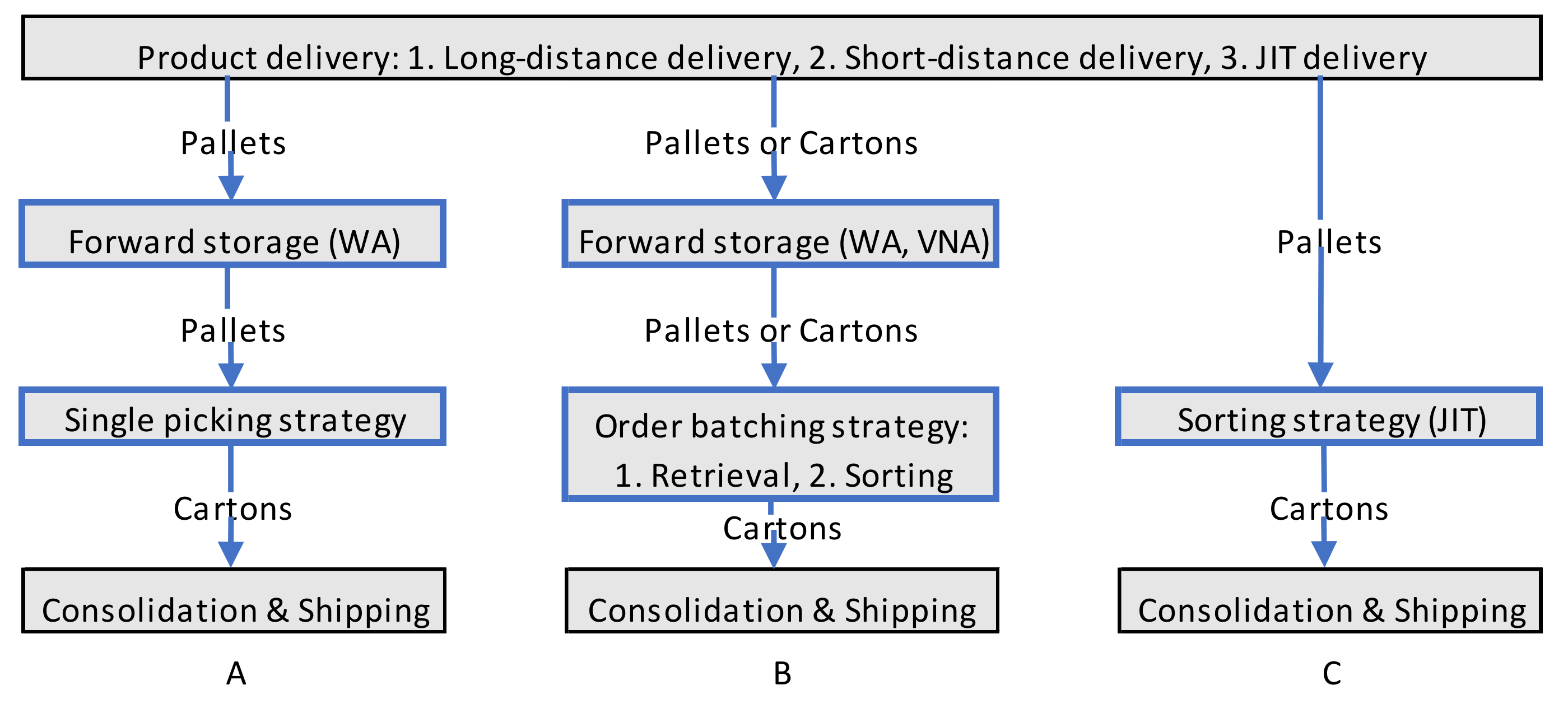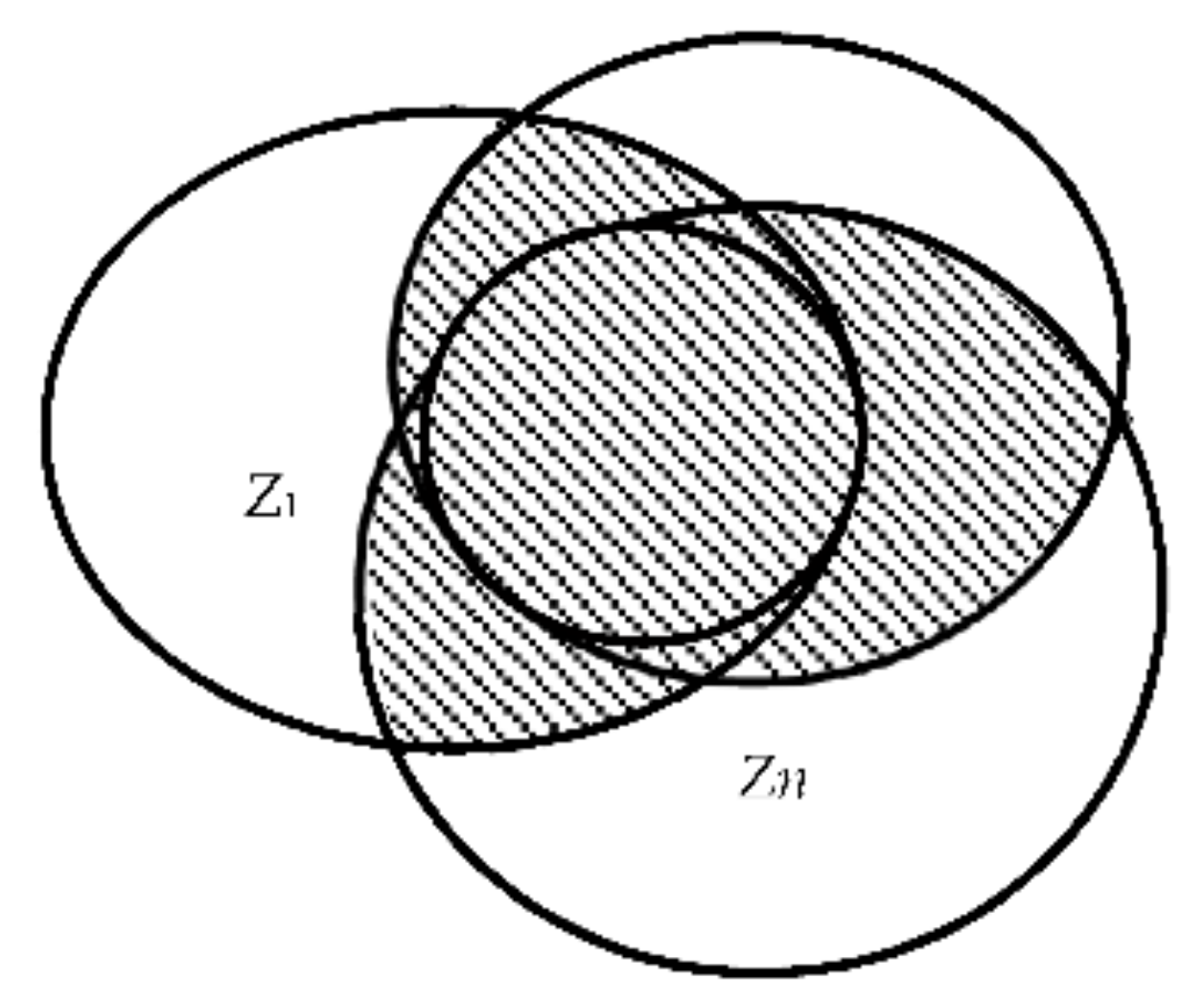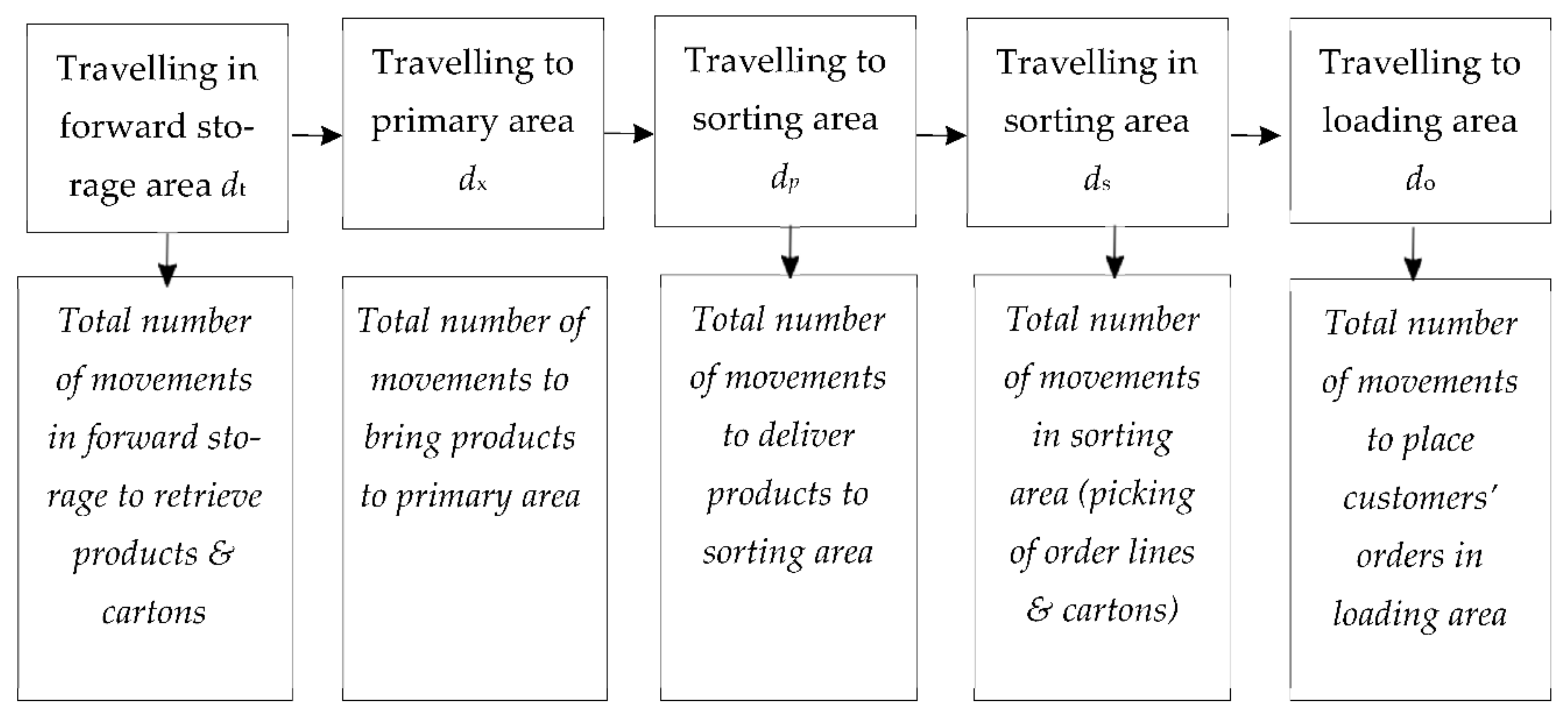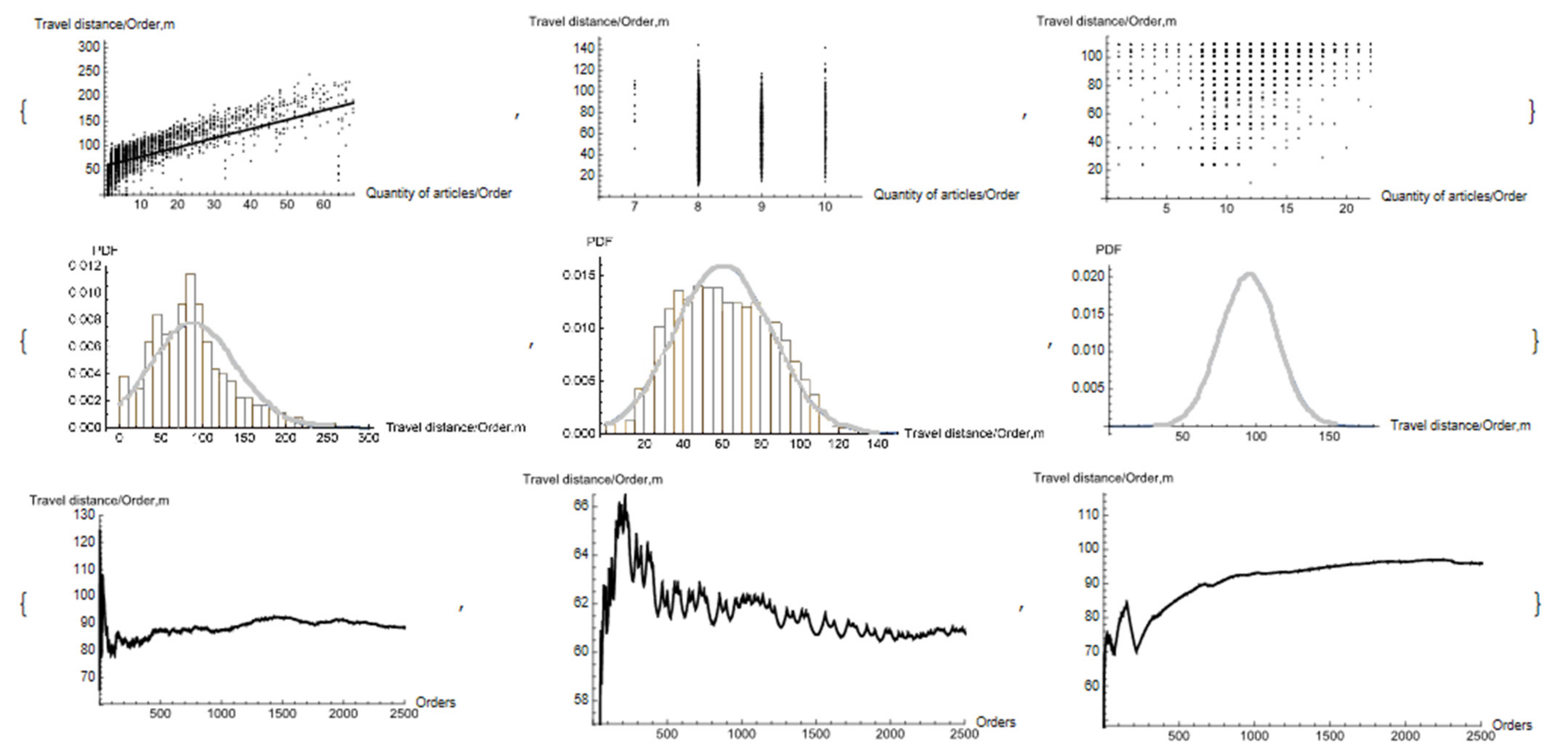Improving Retail Warehouse Activity by Using Product Delivery Data
Abstract
Featured Application
Abstract
1. Introduction
2. Methodology for the Selection of the Order Picking Strategy
2.1. The Revision of Order Picking Strategies by Using Product Delivery Data
2.2. The Application of Order Picking Strategies in Retail Warehouses
3. Review of the Criteria Important for the Selection of Order Picking Strategy by Using Product Delivery Data
Product Delivery Data: Distance Variable
4. Development of Empirical Research Model
4.1. Theoretical Framework
4.2. Cost Analysis
5. Results of Empirical Research
5.1. Statistical Analysis
5.2. Simulation Results
- The single order picking strategy total travel distance equals 236,846 m (for traveling in the forward storage area and traveling from the forward storage to the loading area);
- The order batching strategy total travel distance equals 324,148 m: 111,556 m travel distance is required for product retrieval from the storage (traveling in the forward storage area and delivery to the primary area) and 212,592 m for sorting according to orders (for traveling from primary area to sorting area, traveling in the sorting area, and traveling from sorting area to loading area);
- The sorting strategy total travel distance equals 212,592 m for sorting to business customers’ orders (for traveling from receiving area to sorting area, traveling in the sorting area, and traveling from sorting area to the loading area). The receiving area is located at the same distance as the primary area, and the sorting area has the same attributes.
5.3. Comparison of Order Picking Strategies by Using Product Delivery Data
6. Discussion
7. Conclusions
Author Contributions
Funding
Conflicts of Interest
References
- Wang, Y.; Peng, S.; Xu, C.; Assogba, K.; Wang, H.; Xu, M.; Wang, Y. Two-echelon logistics delivery and pickup network optimization based on integrated cooperation and transportation fleet sharing. Expert Syst. Appl. 2018, 113, 44–65. [Google Scholar] [CrossRef]
- Montoya-Torres, J.R.; Muñoz-Villamizar, A.; Vega-Mejía, C.A. On the impact of collaborative strategies for goods delivery in city logistics. Prod. Plan. Control 2016, 27, 443–455. [Google Scholar] [CrossRef]
- Kong, L.; Li, H.; Luo, H.; Ding, L.; Zhang, X. Sustainable performance of just-in-time (JIT) management in time-dependent batch delivery scheduling of precast construction. J. Clean. Prod. 2018, 193, 684–701. [Google Scholar] [CrossRef]
- Lu, E.H.-C.; Yang, Y.-W. A hybrid route planning approach for logistics with pickup and delivery. Expert Syst. Appl. 2019, 118, 482–492. [Google Scholar] [CrossRef]
- Hsieh, L.-F.; Tsai, L. The optimum design of a warehouse system on order picking efficiency. Int. J. Adv. Manuf. Technol. 2006, 28, 626–637. [Google Scholar] [CrossRef]
- Van den Berg, J.P.; Zijm, W.H. Models for warehouse management: Classification and examples. Int. J. Prod. Econ. 1999, 59, 519–528. [Google Scholar] [CrossRef]
- Jiang, X.; Zhou, Y.; Zhang, Y.; Sun, L.; Hu, X. Order batching and sequencing problem under the pick-and-sort strategy in online supermarkets. Procedia Comput. Sci. 2018, 126, 1985–1993. [Google Scholar] [CrossRef]
- Leung, K.; Lee, C.K.; Choy, K. An integrated online pick-to-sort order batching approach for managing frequent arrivals of B2B e-commerce orders under both fixed and variable time-window batching. Adv. Eng. Inform. 2020, 45, 101–125. [Google Scholar] [CrossRef]
- Horta, M.; Coelho, F.; Relvas, S. Layout design modelling for a real world just-in-time warehouse. Comput. Ind. Eng. 2016, 101, 1–9. [Google Scholar] [CrossRef]
- Oudijk, D.; Roodbergen, K.J.; de Koster, R.; Mekern, M. Shelf Area Warehouse Simulation. 2002. Available online: http://www.roodbergen.com/warehouse/background.php (accessed on 25 May 2021).
- Van der Gaast, J.P.; Jargalsaikhan, B.; Roodbergen, K.J. Dynamic Batching for Order picking in Warehouses. In Proceedings of the 15th International Material Handling Research Colloquium, Savannah, GA, USA, 23–26 July 2018; Georgia Southern University: Statesboro, GA, USA, 2018; pp. 2–20. [Google Scholar]
- Weidinger, F.; Boysen, N.; Schneider, M. Picker routing in the mixed-shelves warehouses of e-commerce retailers. Eur. J. Oper. Res. 2019, 274, 501–515. [Google Scholar] [CrossRef]
- Pang, K.-W.; Chan, H.-L. Data mining-based algorithm for storage location assignment in a randomised warehouse. Int. J. Prod. Res. 2017, 55, 4035–4052. [Google Scholar] [CrossRef]
- Chen, F.; Wang, H.; Xie, Y.; Qi, C. An ACO-based online routing method for multiple order pickers with congestion consid-eration in warehouse. J. Intell. Manuf. 2016, 27, 389–408. [Google Scholar] [CrossRef]
- Van Gils, T.; Caris, A.; Ramaekers, K. The Effect of Storage and Routing Policies on Picker Blocking in a Real-life Narrow-aisle Warehouse. In Proceedings of the International Conference Harbor Maritime and Multimodal Logistics, Barcelona, Spain, 18–20 September 2017; Rende Publisher: Rende, Italy; pp. 53–61. [Google Scholar]
- Lu, W.; McFarlane, D.; Giannikas, V.; Zhang, Q. An algorithm for dynamic order-picking in warehouse operations. Eur. J. Oper. Res. 2016, 248, 107–122. [Google Scholar] [CrossRef]
- Cano, J.A.; Correa-Espinal, A.A.; Gómez-Montoya, R.A. An evaluation of picking routing policies to improve warehouse efficiency. Int. J. Ind. Eng. Manag. 2017, 8, 229–238. [Google Scholar]
- Saragih, N.I.; Bahagia, S.N.; Syabri, I. A heuristic method for location-inventory-routing problem in a three-echelon supply chain system. Comput. Ind. Eng. 2019, 127, 875–886. [Google Scholar] [CrossRef]
- Franzke, T.; Grosse, E.H.; Glock, C.; Elbert, R. An investigation of the effects of storage assignment and picker routing on the occurrence of picker blocking in manual picker-to-parts warehouses. Int. J. Logist. Manag. 2017, 28, 841–863. [Google Scholar] [CrossRef]
- Dijkstra, A.S.; Roodbergen, K.J. Exact route-length formulas and a storage location assignment heuristic for picker-to-parts warehouses. Transp. Res. Part E Logist. Transp. Rev. 2017, 102, 38–59. [Google Scholar] [CrossRef]
- Gibson, D.R.; Sharp, G.P. Order batching procedures. Eur. J. Oper. Res. 1992, 58, 57–67. [Google Scholar] [CrossRef]
- Clarke, G.; Wright, J.W. Scheduling of Vehicles from a Central Depot to a Number of Delivery Points. Oper. Res. 1964, 12, 568–581. [Google Scholar] [CrossRef]
- De Koster, M.B.M.; Van der Poort, E.S.; Wolters, M. Efficient order batching methods in warehouses. Int. J. Prod. Res. 1999, 37, 1479–1504. [Google Scholar] [CrossRef]
- Elsayed, E.A. Algorithms for optimal material handling in automatic warehousing systems. Int. J. Prod. Res. 1981, 19, 525–535. [Google Scholar] [CrossRef]
- Ho, Y.-C.; Su, T.-S.; Shi, Z.-B. Order-batching methods for an order-picking warehouse with two cross aisles. Comput. Ind. Eng. 2008, 55, 321–347. [Google Scholar] [CrossRef]
- Pedrielli, G.; Vinsensius, A.; Chew, E.P.; Lee, L.H.; Duri, A.; Li, H. Hybrid order picking strategies for fashion E-commerce warehouse systems. In Proceedings of the 2016 Winter Simulation Conference (WSC), Washington, DC, USA, 11–14 December 2016; IEEE: New York, NY, USA; pp. 2250–2261. [Google Scholar]
- Stinson, M.; Wehking, K.H. Experimental analysis of manual order-picking processes in a Learning Warehouse. Logist. J. 2016, 10, 1–6. [Google Scholar]
- Klodawski, M.; Jachimowski, R.; Jacyna-Golda, I.; Izdebski, M. Simulation Analysis of Order Picking Efficiency with Congestion Situations. Int. J. Simul. Model. 2018, 17, 431–443. [Google Scholar] [CrossRef]
- Giannikas, V.; Lu, W.; Robertson, B.; McFarlane, D. An interventionist strategy for warehouse order picking: Evidence from two case studies. Int. J. Prod. Econ. 2017, 189, 63–76. [Google Scholar] [CrossRef]
- Li, J.; Huang, R.; Dai, J.B. Joint optimization of order batching and picker routing in the online retailers warehouse in China. Int. J. Prod. Res. 2017, 55, 447–461. [Google Scholar] [CrossRef]
- Perez-Rodrıguez, R.; Hernandez-Aguirre, A.; Jons, S. A continuous estimation of distribution algorithm for the online or-der-batching problem. Int. J. Adv. Manuf. Technol. 2015, 79, 569–588. [Google Scholar] [CrossRef]
- Zhang, J.; Wang, X.; Chan, F.T.; Ruan, J. On-line order batching and sequencing problem with multiple pickers: A hybrid rule-based algorithm. Appl. Math. Model. 2017, 45, 271–284. [Google Scholar] [CrossRef]
- Chen, T.-L.; Cheng, C.-Y.; Chen, Y.-Y.; Chan, L.-K. An efficient hybrid algorithm for integrated order batching, sequencing and routing problem. Int. J. Prod. Econ. 2015, 159, 158–167. [Google Scholar] [CrossRef]
- Henn, S.; Koch, S.; Wäscher, G. Order batching in order picking warehouses: A survey of solution approaches. In Warehousing in the Global Supply Chain; Manzini, R., Ed.; Springer: London, UK, 2012; pp. 105–137. [Google Scholar]
- Ma, T.; Zhao, P. A review of algorithms for order batching problem in distribution center. In Advances in Intelligent Systems Research, Proceedings of the 2014 International Conference on Logistic Engineering, Managing and Computer Science, Shenyang, China, 24–26 May 2014; Zhixian, Z., Guiran, C., Zhen, L., Eds.; Atlantis Press: Zhengzhou, China; pp. 172–175.
- Mutingi, M.; Mbohwa, C. Optimizing Order Batching in Order picking Systems: Hybrid Grouping Genetic Algorithm. In Grouping Genetic Algorithms; Mutingi, M., Mbohwa, C., Eds.; Springer International Publishing: Cham, Switzerland, 2017; pp. 121–140. [Google Scholar]
- Pan, J.C.H.; Shih, P.H.; Wu, M.H. Order batching in a pick-and-pass warehousing system with group genetic algorithm. Omega 2015, 57, 238–248. [Google Scholar] [CrossRef]
- Valle, C.A.; Beasley, J.E.; da Cunha, A.S. Optimally solving the joint order batching and picker routing problem. Eur. J. Oper. Res. 2017, 262, 817–834. [Google Scholar] [CrossRef]
- Singh, D.K.; Singh, S. JIT: Various Aspects of Its Implementation. Int. J. Mod. Eng. Res. 2013, 3, 1582–1586. [Google Scholar]
- Ma, G.; Guan, H. The application research of cold-chain logistics delivery schedule based on JIT. In Proceedings of the 2009 International Conference on Industrial Mechatronics and Automation, Changchun, China, 9–12 August 2009; IEEE: New York, NY, USA, 2009; pp. 368–370. [Google Scholar]
- Phan, A.C.; Nguyen, H.T.; Matsui, Y. Effect of Total Quality Management Practices and JIT Production Practices on Flexibility Performance: Empirical Evidence from International Manufacturing Plants. Sustainability 2019, 11, 3093. [Google Scholar] [CrossRef]
- Chen, Z.; Sarker, B.R. Integrated production-inventory and pricing decisions for a single-manufacturer multi-retailer system of deteriorating items under JIT delivery policy. Int. J. Adv. Manuf. Technol. 2017, 89, 2099–2117. [Google Scholar] [CrossRef]
- Dong, Y.; Carter, C.R.; Dresner, M.E. JIT purchasing and performance: An exploratory analysis of buyer and supplier perspectives. J. Oper. Manag. 2001, 19, 471–483. [Google Scholar] [CrossRef]
- Billesbach, T.J.; Harrison, A.; Croom-Morgan, S. Supplier Performance Measures and Practices in JIT Companies in the US and the UK. Int. J. Purch. Mater. Manag. 1991, 27, 24–28. [Google Scholar] [CrossRef]
- Zhou, B.H.; Peng, T. Optimal schedule of just-in-time part distribution for mixed-model assembly lines. J. Jilin Univ. 2017, 3, 47–56. [Google Scholar]
- Wang, H.; Gong, Q.; Wang, S. Information processing structures and decision making delays in MRP and JIT. Int. J. Prod. Econ. 2017, 188, 41–49. [Google Scholar] [CrossRef]
- Tseng, S.-H.; Wee, H.-M.; Reong, S.; Wu, C.-I. Considering JIT in assigning task for return vehicle in green supply chain. Sustainability 2019, 11, 6464. [Google Scholar] [CrossRef]
- Gong, Y. Stochastic Modelling and Analysis of Warehouse Operations. Ph.D. Thesis, Erasmus University Rotterdam, Rotterdam, The Netherlands, 3 September 2009. [Google Scholar]
- Sankar, D. Innovative JIT implementation in manufacturing industry. J. Contemp. Issues Bus. Gov. 2020, 26, 666–671. [Google Scholar]
- Estall, R. Stock control in manufacturing: The just-in-time system and its locational implications. Area 1985, 1, 129–133. [Google Scholar]
- Eurostat: Average Distance on Which Goods Are Carried. 2018. Available online: https://ec.europa.eu/eurostat/statistics-explained/index.php/Road_freight_transport_by_journey_characteristics#Average_distance_travelled (accessed on 11 April 2021).
- Lawler, E.L.; Lenstra, J.K.; Rinnooy, K.; Shomy, D.B. The Travel Salesman Problem: A Guided Tour of Combinational Optimization; Wiley: Paris, France, 1985; pp. 14–476. [Google Scholar]
- Gray, A.E.; Karmarkar, U.S.; Seidmann, A. Design and operation of an order-consolidation warehouse: Models and application. Eur. J. Oper. Res. 1992, 58, 14–36. [Google Scholar] [CrossRef]
- Ministry of Social Security and Labour. Social Statistics. 2021. Available online: https://socmin.lrv.lt/en/administrative-services/social-statistics (accessed on 11 March 2021).
- Howard Handling. Prices of Electric Pallet Trucks. 2021. Available online: https://www.howardhandling.co.uk/electric-pallet-trucks (accessed on 19 March 2021).





| No. of Layer | Functional Aspect | Methods | Results |
|---|---|---|---|
| The first layer (criteria for the selection of order picking strategy) | Review of the criteria presented in the literature | Classification of criteria having an impact on order picking strategy | The extension of current knowledge in linking transport and retail warehouse activities |
| The second layer (product delivery distance data in selecting order picking strategy) | The selection of order picking strategies by using product delivery distance variable | The design of the theoretical framework for empirical investigation | Evaluation of distance variable and the selection of the best results providing order picking strategy |
| The third layer (application of order picking strategy) | The revision of the application of order picking strategies and product delivery possibilities | Comparative analysis of order picking strategies supported by product delivery data | Benchmarking of order picking strategies using product delivery data and its results provision |
| Picking strategies | Problem Family | References |
|---|---|---|
| Picking single order (or pick-by-order) | Discrete picking | [5] |
| Parallel picking of multiple orders (or sort-while-pick) | Parallel picking | [6] |
| Picking batch and sorting into multiple orders (or pick-and-sort) | Batch picking | [3,7] |
| Sorting after picking into multiple orders (or picked-to-sort) | Subsequential sorting | [8] |
| Full-pallet picking (or unit load picking) | Cross-dock | [9] |
| Order picking Strategies | Subject | Author |
|---|---|---|
| Single picking strategy | Retail warehouse | [26] |
| Traditional warehouse | [27,28] | |
| Order batching strategy | Retail warehouse | [29,30,31,32] |
| Traditional warehouse | [33,34,35,36,37] | |
| Order sorting strategy | Traditional warehouse | [38] |
| No | Name of Criteria | Positive Results after the Implementation of Order Picking Strategy by Using Product Delivery Data | Authors |
|---|---|---|---|
| 1 | Large variety of products | Order sorting strategy, JIT delivery | [39] |
| 2 | Short product lifetime | [40] | |
| 3 | Product quality | Order sorting strategy, JIT delivery | [41] |
| 4 | Higher service quality | Order sorting strategy, JIT delivery | [42,43,44] |
| 5 | Synchronization of delivery and picking schedule | Order sorting strategy, JIT delivery | [40,45] |
| 6 | Sharing information | Order sorting strategy, JIT delivery | [46] |
| 7 | Reduction in inventory level | Order sorting strategy, JIT delivery | [47] |
| 8 | Reduction in costs | Order picking from storage strategies: single picking, parallel picking, order batching strategies | [48] |
| 9 | Increase in pickers’ productivity | Order sorting strategy, JIT delivery | [9] |
| No | Distance Criteria, km | Product Delivery |
|---|---|---|
| 1 | Up to 140 km | JIT delivery |
| 2 | Up to 149 km | Short-distance delivery |
| 3 | Between 150 and 299 km | Intermediate-distance delivery |
| 4 | Between 300 and 1000 km | Long-distance delivery |
| Regression Data | Equal to | Values |
|---|---|---|
| Correlation coefficient | = | 0.82 |
| R-squared | = | 0.686125 |
| T statistic | = | 76.326 |
| T table | = | 1.96 |
| Coefficients | = | |
| a0 | = | 58.921 |
| a1 | = | 1.89168 |
| The adequacy of the equation | = | |
| F statistic | = | 5825.65 |
| F table | = | 3.84 |
| Lines | From Storage Area (i.e., Forward Storage) Single Picking Strategy | From Storage Area Order Batching Strategy | From Receiving Area Order Sorting Strategy | |
|---|---|---|---|---|
| From Forward Storage Area Retrieval from Storage | From Primary Area Sorting by Customers’ Orders | |||
| Travel distance per order (meters) | 88.79 | 60.43 | 95.18 | 95.18 |
| Dispersion | 51.49 | 25.06 | 19.54 | 19.54 |
| No | Distance Criteria, km | % | Product Delivery |
|---|---|---|---|
| 1 | Up to 140 km | 47.4% | JIT delivery |
| 2 | Up to 149 km | 47.4% | Short-distance delivery |
| 3 | Between 150 and 299 km | 11.7% | Intermediate-distance delivery |
| 4 | Between 300 and 1000 km | 40.8% | Long-distance delivery |
| Components of Costs | Single Picking Strategy | Order Batching Strategy | Order Sorting Strategy | |
|---|---|---|---|---|
| EUR/Order Line | Retrieval from Storage | Sorting by Customers’ Orders | ||
| Labor costs per order line, EUR | 0.015 | 0.003 | 0.007 | 0.007 |
| Equipment costs per order line, EUR | 0.017 | 0.003 | 0.008 | 0.008 |
| Total costs per order line, EUR | 0.033 | 0.022 | 0.015 | |
| Difference comparing with single picking strategy per order line, % | – | 33.37% | 53.37% | |
| The average difference comparing with single picking strategy per order line, % | – | 43.37% | ||
| Summary of Statistics | Minimum | Maximum | Mean | Standard Deviation |
|---|---|---|---|---|
| Index size, % | 28 | 42 | 35 | 11.8 |
Publisher’s Note: MDPI stays neutral with regard to jurisdictional claims in published maps and institutional affiliations. |
© 2021 by the authors. Licensee MDPI, Basel, Switzerland. This article is an open access article distributed under the terms and conditions of the Creative Commons Attribution (CC BY) license (https://creativecommons.org/licenses/by/4.0/).
Share and Cite
Burinskienė, A.; Lerher, T. Improving Retail Warehouse Activity by Using Product Delivery Data. Processes 2021, 9, 1061. https://doi.org/10.3390/pr9061061
Burinskienė A, Lerher T. Improving Retail Warehouse Activity by Using Product Delivery Data. Processes. 2021; 9(6):1061. https://doi.org/10.3390/pr9061061
Chicago/Turabian StyleBurinskienė, Aurelija, and Tone Lerher. 2021. "Improving Retail Warehouse Activity by Using Product Delivery Data" Processes 9, no. 6: 1061. https://doi.org/10.3390/pr9061061
APA StyleBurinskienė, A., & Lerher, T. (2021). Improving Retail Warehouse Activity by Using Product Delivery Data. Processes, 9(6), 1061. https://doi.org/10.3390/pr9061061







